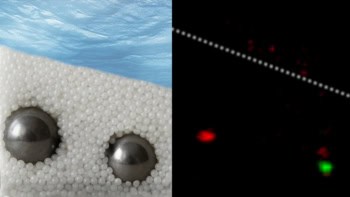Physicists who want to study the wavefunctions of electrons confined in less than three dimensions usually have to make do with two dimensional collections of atoms arranged "by hand" on metal surfaces. Now, however, physicists in Canada have been able to create parallel one-dimensional stripes of molecules that self-assemble on a surface. The technique could make it much easier to study and control electron wavefunctions in low-dimensional systems (Nature Nanotechnology 2 99).
Confining and controlling electrons onto metal surfaces is an awkward task, and currently researchers do this by carefully positioning single atoms using techniques such as scanning electron microscopy (STM). But these “top down” methods are either time consuming or difficult to control, so make it hard to engineer ensembles of confining nanostructures.
Now, a team led by Johannes Barth at the University of British Columbia in Vancouver have developed a new “bottom up” approach, whereby molecules of the amino acid “methionine” assemble themselves onto silver surfaces. To create the nanostructures, the physicists prepared a highly regular surface of silver by heating and rapidly cooling it. They then deposited a beam of methionine onto the substrate, and observed as the molecules formed periodic stripes on the substrate.
This unusual ordering, which required no direct intervention, resulted because methionine is one of few amino acids that contain sulphur atoms. These sulphur atoms interact with the surface of the substrate when they are adsorbed, forming electron-reflecting walls that (as verified by scanning tunnelling spectroscopy) can confine electron wavefunctions to one dimension.
Barth told Physics Web that the periodicity of the 1D stripes can be tuned in “exquisite detail” by simply altering the concentration of methionine molecules on the surface. Furthermore, by arranging single atoms of iron along the silver stripes using STM, his team could reduce the system to zero dimensions. “We believe that the ease, versatility and elegance of the bottom-up strategy will attract widespread attention,” he said.



